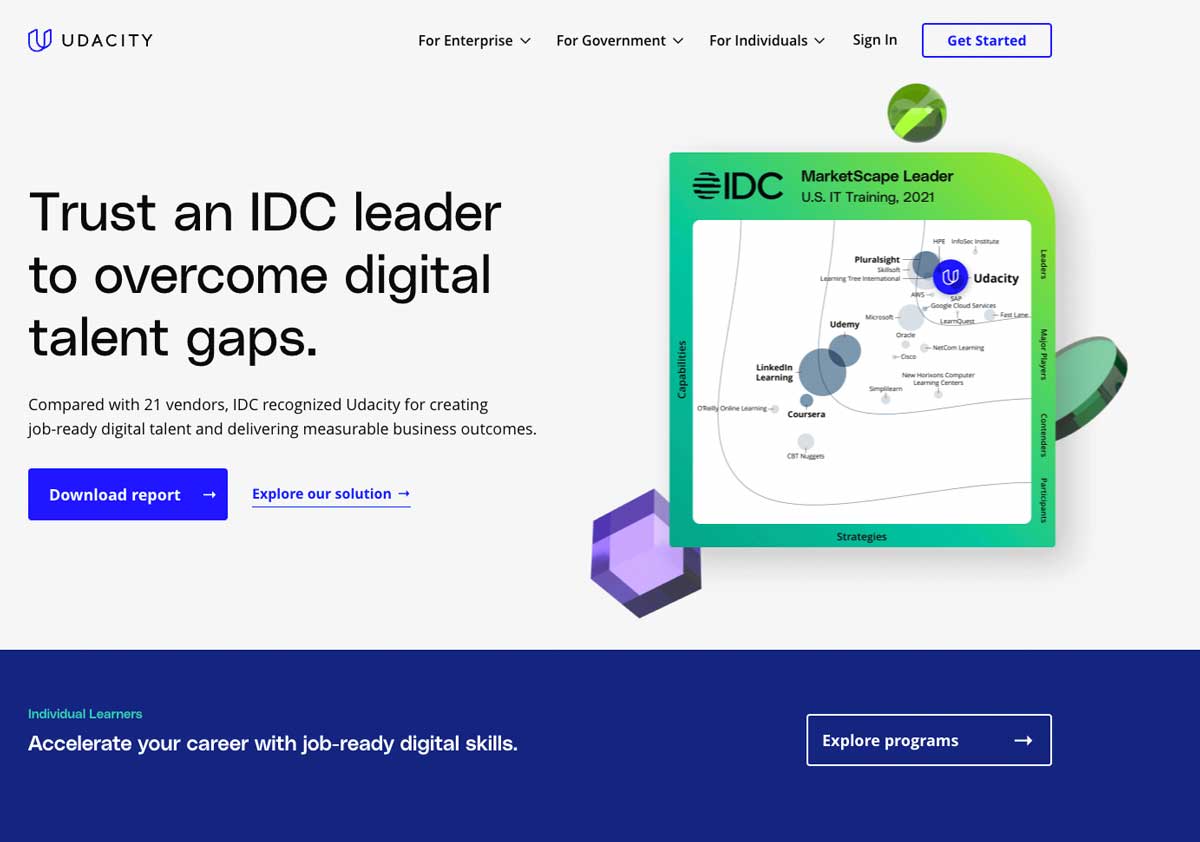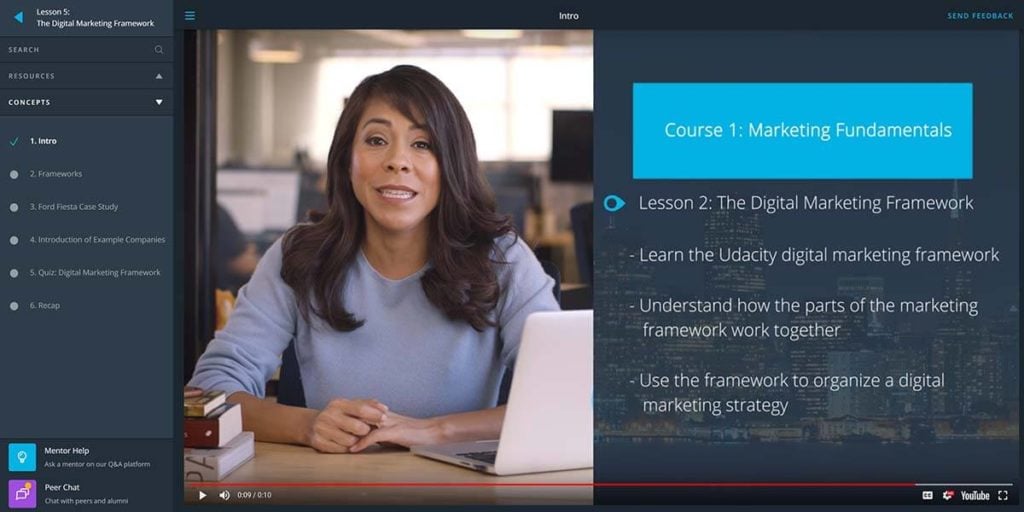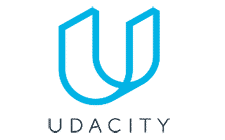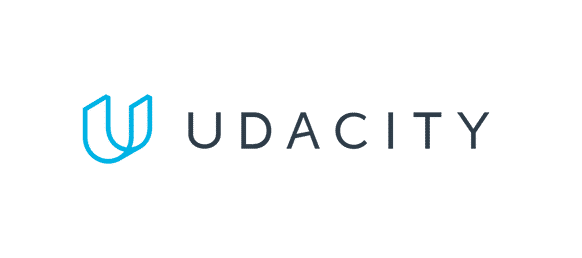“We are audacious for you, the student.” According to co-founder Sebastian Thrun, that’s where the name “Udacity” came from. Audacity signifies bravery, and it’s a fitting word for the online education platform. Why so, you might ask?
Well, I say that because Udacity has been one of the pioneers of the e-learning industry. In June of 2011, when Udacity was launched, MOOC sites were not as mainstream as they are now. Major online education platforms such as Coursera and edX did not exist at the time. Starting a MOOC company in the summer of 2011 demanded bravery and a willingness to fail.
But they did not fail. Not in the slightest. In fact, their audacity paid off in a major way. Udacity became a unicorn company worth $1 billion in 2015 – four short years after its creation. And the numbers have kept growing since then. In 2022, the number of online students taking Udacity courses rose to a staggering 16.9 million.
Udacity is one of the very few e-learning platforms that has succeeded right from the get-go. Take Udacity’s very first course, an introductory course on artificial intelligence, for example. This course garnered massive interest with more than 150,000 enrolled students.
With stats such as these, it’s clear that Udacity is an online course giant that cannot be ignored. But with the cost of Nanodegrees having gone up in recent years, is Udacity still worth it in 2023? Let’s find out the answers to these questions in my review of Udacity.
Table of Contents
What is Udacity?

Udacity is a for-profit online education platform based out of Silicon Valley. The platform focuses on its signature brand of high-quality micro-credential programs (Nanodegrees) that are somewhere between a normal online course and a high-intensity boot camp.
Udacity’s courses arise from partnerships with well-known corporations in Silicon Valley, for example, Google, Facebook, Nvidia, and Amazon. Through these partnerships, Udacity’s aim is to provide students with up-to-date practical knowledge. And they focus on teaching the skills that are currently most needed in these companies.
This is also why tech-related courses are Udacity’s most popular category and why they have a reputation for designing courses that provide you the skills to actually land a job in the tech sector. These corporations need experts in technology above all else – and Udacity has made it their mission to train them.
However, Udacity’s Nanodegrees and courses are not restricted to programming topics. Udacity also offers some fantastic courses in areas such as Data Science and Business (with a tech focus). In fact, my personal experience with Udacity also comes from a Business-related Nanodegree. That program is Udacity’s Digital Marketing Nanodegree from the Business category. I will highlight my experiences from that throughout this review of Udacity.
Who is Udacity’s CEO?
Following the departure of Gabe Dalporto in October 2022, co-founder Sebastian Thrun is again back as the CEO of the company (he is otherwise serving as President and Chairman of the Board). The other two co-founders, David Stavens and Mike Sokolsky, work on various A.I. projects unrelated to Udacity.
Is Udacity accredited?
Udacity has a strong focus on vocational, rather than academic, training and is not an accredited educational institution. Udacity’s programs will generally not provide you with credit for your academic studies. Udacity’s certificates are, however, valued by tech corporations looking for new employees.
What Courses Does Udacity Offer?
Unlike most other MOOC platforms, Udacity has a very straightforward structure to what they are offering.
For example, Coursera offers a whole range of different types of products with often somewhat confusing names: Courses, Specializations, Professional Certificates, MasterTracks, online degrees, and various university certificates. Add a Coursera Plus subscription alternative on top of that, and you need to do some serious research before you choose what you would like to sign up for.
Udacity, on the other hand, only offers two kinds of products: free courses and their signature program, the Nanodegree.
The 187 free courses currently offered via Udacity are varied in their content, scope, and level. Some are short courses that are used to introduce you to their paid offerings, while others are remnants from legacy programs (such as Georgia Tech’s Online Master of Science in Computer Science, which was offered via Udacity until 2020). While the selection of courses is a bit random, what they have in common is that they tend to be of excellent quality – you will find some of the best free courses in tech in Udacity’s free course catalog. What they all lack is the interactivity and support featured in the Nanodegrees.
Udacity currently offers 80 Nanodegrees that are being offered by its eight “Schools”:
- School of Artificial Intelligence
- School of Autonomous Systems
- School of Business
- School of Cloud Computing
- School of Cybersecurity
- School of Data Science
- School of Product Management
- School of Programming & Development
We’ve compiled a table with all the Nanodegrees currently offered by Udacity at the bottom of this article so you can easily get an overview.
Note that these Schools are primarily a way to organize their courses by broader topic – there is little, if any, independence between them, and several of the Nanodegrees are listed by multiple Schools.
The Nanodegrees vary in duration from one to six months, in general estimating about 10 hours of work per week. Apart from giving you an idea about the scope of the course, it also has a direct bearing on the cost – more on that in the pricing section below. The majority of Nanodegrees are either three or four months long. Importantly, it is possible to finish a Nanodegree faster than its estimated duration.
The Nanodegrees are sorted into three difficulty levels: Beginner, Intermediate, and Advanced. Most of them are Beginner or Intermediate level, but there are enough Advanced programs to keep those already with considerable experience in the sector interested in the course offerings. Beginner-level Nanodegrees have no, or very limited, prerequisites, meaning that you can get started even if you have no knowledge of programming or similar (a good place to start in that case is their Introduction to Programming Nanodegree)
How Does Udacity Work?
Studying at Udacity is a very simple process. It’s easy even for someone who has never taken an online course before. To clarify, the program I took on Udacity was the Digital Marketing Nanodegree. Thus, that’s what I will be using as my point of reference. It’s important to realize that other Nanodegree programs might differ in some ways. But, the basic working process of Udacity is consistent across the different Nanodegrees.
Taking a Nanodegree on Udacity involves the following steps:
Choosing a course
There’s a good variety of online courses and Nanodegrees available on Udacity. That is why choosing the correct one for yourself is the most important step in the learning process. The first thing to remember here is that you should not choose a course based on a moment’s impulse. Instead, look at the list of topics and pay attention to what you could turn into a career.
Udacity emphasizes career-building and landing a high-paying job after graduation. Thus, if you want to take full advantage of Udacity, you should also consider this when picking a course. Choose a field that you can establish a long-term career in. A personal recommendation of mine? Look at Udacity’s data science courses.
Paying the tuition fees
After deciding on the program you want to take, it’s now time to subscribe to it. Udacity offers various payment options, including PayPal and credit cards. Note that the free courses on Udacity will not require payment or entering your credit card details.
And as Udacity’s courses don’t come cheap, make sure that you make the most of the courses you subscribe to. Pour as much time and effort into the curriculums as you can. By doing this, you will ensure that you get your money’s worth.
Course onboarding
When you first start an online course on Udacity, you will go through onboarding. During onboarding, you will prepare both yourself and Udacity for the upcoming studies. In particular, this includes the following:
- Filling a questionnaire
- Previewing the syllabus
- Planning a personal study schedule
- Setting personal study reminders (syncs with calendaring software)
This type of extensive onboarding aims to prepare you for the program and to help you make the most of it. Also, it’s purpose is to help you set concrete goals for progressing through the syllabus. That’s what the study reminders and personal study schedules are for. Overall, Udacity’s onboarding is some of the best I’ve ever seen. It’s simple but effective at preparing students for the digital studies.
Going through the course lessons

Once you finish the onboarding, it’s now finally time to start learning. From the left-side menu, you can access the syllabus, and you can jump to any point in the curriculum. This is helpful if you want to change the order of lessons around. After all, every student has different needs, and some might prefer to start from the middle – or even the end.
Now, as for the course lessons themselves, most of them are split into 10-20-minute segments. And, from my experience, a large portion of Udacity’s course lessons are video lectures. This is both a positive and a negative for me. I do enjoy video-based lectures if done right. And, Udacity’s video lectures are some of the best out there. But, I can never motivate myself to sit through dozens of hours of video-based curriculums. That is if there’s no practical work in-between. Thankfully, Udacity’s courses do include quizzes and graded student projects besides videos.
Taking quizzes
As you go through the course lessons on Udacity, now and then, you’ll be asked to take a quiz. These quizzes usually come at the end of course units and serve as a way to ensure that you understand the lesson materials.
From my experience, Udacity’s quizzes are quite easy to pass. That is if you pay attention to the lessons and take notes while doing so. However, Udacity’s quizzes are not so easy that you’ll be able to nail them based on guessing alone.
Taking this into consideration, I think Udacity’s quizzes are good at what they do. Many other MOOC platforms I have tried don’t get quizzes right. Some MOOCs have had quizzes that don’t relate whatsoever to the course material. It’s frustrating to spend hours studying only to find that you don’t know the answers to any of the quiz questions. Udacity, though, did a good job with this. The quizzes come from the lessons, and if you pay attention to the lessons – you will also pass the quizzes.
Completing graded projects
At the very core of Udacity’s teaching system are the graded student projects. These are real-world projects that get reviewed by expert mentors. And their main aim is to provide students with practical experience.
Mentorship through these types of projects is an integral part of Udacity’s syllabi. To make the most of your Nanodegree, make sure to ask questions from your mentors. And here’s another tip: take part in student-to-student discussions. These can be just as valuable as talking to a mentor. Udacity’s entire learning system is based on these graded projects. Thus, you should make sure that you take full advantage of them whenever you can.
Graduating with a certificate
To qualify for a Udacity certificate, you need to fulfill the following criteria:
- Pass all the course lessons
- Complete all the projects with a grade of
“Meets Expectations”
That’s it! Completing a Udacity Nanodegree is very simple in principle. Yet, it takes time and effort to fulfill these two aspects – especially the projects. To get your money’s worth of value out of your Nanodegree, make sure that you do it not only for the certificate but also for the knowledge.
Taking advantage of career services
This step does not have to come at the end. You can make use of Udacity’s career support resources the very second you enroll in a Nanodegree. But I listed it as the final step because it’s not directly connected to the course syllabus. Instead, it serves on its own as an individual feature.
Udacity’s career resources include the following:
- Cover letter reviews
- Resume review
- LinkedIn review
- GitHub review
All these services are very useful if your goal is to establish a new career. By taking a Nanodegree, you’ll get access to resume templates and a network of tech companies. It’s worth mentioning that Udacity no longer guarantees a job proposal for graduates. Yet, they still do their best to ensure that their graduates have good career prospects.
Review of Udacity's Pricing & Costs
The cost of taking an online course or Nanodegree on Udacity largely depends on which of them you choose. To be specific, the cost mostly depends on the length of the program. In the last few years, Udacity has moved to a subscription-based pricing model. This means that if you want to take a Nanodegree, you’ll have to pay a monthly fee for doing so. Thus, the cost of the program is directly connected to its monthly duration.
The free online courses available on Udacity don’t require any payment or that you enter your credit card details.
Udacity used to have a fixed pricing model, meaning that all Nanodegrees would cost a one-time fee. This type of pricing model is fairer to the user in many ways. After all, paying a one-time fixed fee means that you buy access to the course, and that’s that. You can take the course at your own pace, and there’s no hurry.
With subscription-based pricing, however, Udacity students may feel that they have to rush through the course lessons. That is unless they want to spend money on monthly fees. Yet, I wouldn’t be too quick to criticize this change in pricing. That is because some students can even stand to benefit from this change in the pricing model. More on this below.
How much does Udacity cost?
The monthly subscription costs for Udacity’s Nanodegrees are currently $399 per month. Students can also pay for multiple months simultaneously with a 15% discount – this is highly recommended if you don’t plan to rush through the course to save money.
How can I save money on Nanodegree costs?
There are a couple of ways to reduce the total price of a Nanodegree. These are the methods I would recommend:
- Take advantage of discount codes
- Finish the Nanodegree as fast as possible
- Apply for Udacity scholarships and personalized discounts
The first method, discounts, requires you to find discount codes online, which can be frustrating as these days, there is an overwhelming number of websites purportedly offering discounts that are trying to scam you. However, as Udacity is an important resource for many E-student.org readers, we negotiate with Udacity to try to bring down the price and bring you the best offers that they are able to offer. E-student.org learners can get 25% off their program by using this link and then entering code CAREER25 at checkout. This is best combined with prepaying for the full duration of the Nanodegree, as this gives you an additional 15% off. There is also a “personalized discounts” program that you can access here.
The second cost-reducing method, finishing the Nanodegree ASAP, is rather obvious. As Udacity’s new pricing model is based on monthly payments, you can take advantage of that. Reduce Nanodegree costs by completing the program in fewer months than the official estimation. By doing so, you’ll have fewer monthly payments to make, and you’ll save a decent chunk of money. However, note that we’ve found that, in general, the recommended number of months for the course is a reasonable estimate for what is needed to properly complete the projects and make use of the mentor support. Note that this strategy also means that you can not save money by getting the prepayment discount.
The final cost-reducing method, scholarships, is also rather straightforward. Take a look at Udacity’s scholarships page. See if there are any open scholarships that you might qualify for. If there are, send in an application and hope for the best. Udacity also has an ongoing program of personalized discounts – you can easily apply for them here.
Review of Udacity Nanodegrees
In this section, I will review Udacity’s Nanodegrees. This will be an evaluation based on my personal experiences of taking the Digital Marketing Nanodegree.
Nanodegrees tend to be the first thing that comes to people’s minds when they think of Udacity – it’s the flagship product of the platform, and many success stories of graduates are floating around the internet. Stories of people starting lucrative jobs at Google or Facebook after finishing a Nanodegree.
Yet, these success stories should not come as a surprise to anyone. After starting out – like Coursera and edX – with primarily academic partnerships, Udacity fairly early on switched over to a strong focus on vocational training and partnering with tech industry giants. If the tech industry lacks professionals in a specific area, then Udacity has been nimble to create a well-designed Nanodegree that pinpoints the specific skills that are in demand by those companies.
The user-friendliness, feedback mechanisms, and high production value of the course materials place the Nanodegrees above the vast majority of tech courses. And with extensive career support services and best-in-class user experience, Nanodegrees become very appealing for those looking for a new career. These are some of the reasons why Udacity is one of my favorite platforms for online education. But given its price, it’s important to evaluate Nanodegrees based on cost-effectiveness. The question is – are Nanodegrees worth it?
What is a Nanodegree?
Nanodegrees are online certification programs offered exclusively on Udacity. Udacity’s Nanodegrees offer a cost and time-effective alternative to traditional degrees. They are generally comparable in scope to edX’s MicroMasters programs and Coursera’s MasterTrack programs – but without the academic partners and credit. In this video, Sebastian Thrun, the co-founder of Udacity, explains Nanodegrees.
Sebastian describes Nanodegrees as short versions of certificates. He emphasizes the value of teaching in-demand skills quickly. That is unlike traditional degrees that need years of time and effort to complete. He believes that if this type of online education becomes optimized, it will double the world’s GDP.
Can you get a job with a Nanodegree?
Yes, you can. Many of Udacity’s graduates get lucrative jobs after finishing a Nanodegree. For example, Jennifer Person started working at Google after finishing the iOS Developer Nanodegree. Apart from the quality of the courses, Udacity’s career services that come included with every Nanodegree play an important role in helping graduates translate their skills into jobs.
How long does a Nanodegree take?
The length of Udacity’s Nanodegrees depends on the learner. Nanodegrees all have estimated durations, which range between one and six months, with the majority of them either three or four months long. These estimates assume about ten hours of active work per week – although the amount of work required will vary quite a lot depending on your pre-existing familiarity with a topic.
However, the courses are self-paced, and fact-paced students can finish a course faster (although speeding through a course may impact their learning negatively). For example, a six-month Nanodegree can be finished in less than four months by quick and organized students.
Are Udacity Nanodegrees recognized?
Udacity’s Nanodegrees are not accredited and generally will not give you any academic credit. But they were never meant for that. Instead, the recognition of Udacity’s Nanodegrees comes from employers, such as Google, Amazon, and Facebook, valuing the certificates as part of their hiring processes. So while Nanodegrees are not recognized by academia, the many success stories of graduates show that they are recognized by corporations.
Are Udacity Nanodegrees worth it?
Generally speaking, my Udacity Nanodegree was well worth the cost. The mentorship, graded projects, expert interviews, and free access to paid tools alone would justify the cost. And, the career services and well-built curricula give it even more value. But, without discounts, the prices of Nanodegrees are still high. Thus, I would recommend you to either wait for discounts or to use a coupon code such as ours when you buy a Nanodegree.
Advantages (Pros) of Udacity
Udacity’s online courses and Nanodegrees have many advantages over their competitors. Their MOOCs have gone through some considerable changes throughout the years. And, many of these changes have been positive. All in all, I can say that my review of Udacity was a very positive experience.
These are the biggest benefits of Udacity:
Well-built user interface
Udacity’s user interface has gone through several redesigns over the last few years. I’ll be the first to say that I was not a fan of their initial design choices. The menus were bland, the homepage was empty, and the color choices were very boring. But, year by year, they have turned a mediocre user experience into something excellent.
As of right now, Udacity’s user experience and design are the best out of all MOOC sites I have seen. Continuing course lessons from the menu are simple. It’s very easy to see upcoming deadlines for graded projects. And there is quick access to the course outline. This gives you the chance to jump back to previous or upcoming lessons whenever you need to do so.
Udacity’s user interface design is human-centric, easy to use, and effective. Without a doubt, it’s one of my favorites when it comes to online education providers.

Nanodegrees contain expert interviews
While studying for my Nanodegree, I was a big fan of the expert interviews. Placed throughout the curricula, they kept the course lessons very captivating for me. So, what do I mean by expert interviews?
For example, in the first week of the Digital Marketing Nanodegree, there was an interview with the president and COO of Change.org, Jennifer Dulski. In this interview, Jennifer shared her experiences in creating a digital marketing strategy. A strategy for Change.org, which has over 300 employees and $15 million in revenue. It was intriguing to listen to her strategies and actionable tips for marketers.
And, as the interview was right at the beginning of the syllabus, it gave me a strong motivational push. A push to keep working through the curriculum. While the theory is important, hearing real-life stories from experts is as important. I have not seen interviews implemented to such an extent on any other MOOC platform. I loved it.
Strong mentor support
All of Udacity’s Nanodegrees include mentor support. The mentors are there to guide you throughout your studies. They will answer any questions you have, and they give expert feedback for your projects. Student projects are one of the main learning tools on Udacity, and high-quality mentorship is critical to make these good learning experiences.
Many online students abandon MOOCs when they get stuck for one reason or another, and the lack of feedback is a common problem in e-learning. Ready-to-help mentors help to combat this and to raise the retention rates of students.
Industry-expert mentors are one of the biggest benefits of taking a Udacity Nanodegree. While Udacity has recently come under fire for reducing the salaries of their mentors, I did not notice this having any effect in practice on the quality of the mentor system. And with Sebastian Thrun being back in Udacity’s managerial positions, I’m hoping that this will remain a priority.
High-quality graded student projects
As mentioned, all Nanodegrees include graded real-world projects. The projects are designed to give you practical experience in the field you are studying. In programming courses, this could mean creating real-world applications. In digital marketing courses, this could mean creating a real Facebook Ad campaign. Or, it could encompass writing a document or creating a design.
These student projects are a superb way of hammering in the theoretical lessons. Combined practice and theory are much more effective than theory alone, after all. To master almost any educational field, you need a combination of both.
Udacity’s student projects are an excellent way to give online students practical experience. And combined with mentorship, these projects became all the more valuable.
Active student discussion forums
Some years ago, Udacity’s greatest weakness was the lack of an effective student forum. But recently, it seems they realized their weakness and managed to fix the hole in their arsenal of learning tools.
Now, students have access not only to mentor help but to a feature called “Peer Chat.” In Peer Chat, students can collaborate and create discussions with each other. I enjoyed seeing students answer each other’s questions and support each other. It reminded me of the “push each other” mentality from traditional universities.
Udacity’s student discussion forums are not yet on the same level as FutureLearn. But, Udacity has come a long way in the last few years. I’m excited to see what other improvements they have in store for the platform.
Best-in-class career resources
Taking an online course or Nanodegree on Udacity comes with one of the best suites of career resources I have seen out of an online learning platform.
You will get help preparing for job interviews and writing a strong resume. Also, an expert will look over your LinkedIn and GitHub profiles to see if there’s any room for improvement. Finally, Udacity will distribute your resume to a network of potential employers. These are the same corporations that Udacity has a partnership with. For those who forgot – this includes companies such as Google and Nvidia.
Disadvantages (Cons) of Udacity
I highlighted many fantastic benefits of being an online student on Udacity. But, it’s not all flowers and sunshine. Udacity also has disadvantages worth considering before committing to a course.
These are the biggest disadvantages of Udacity:
No Udacity app
Udacity used to have an iOS and Android app. But, they removed it from the App Store and Google Play Store at the beginning of 2019. In Udacity’s own words, the discontinuation was to “upgrade the learning experience.” Yet, several years have passed since then, and there are still no signs of this being reversed – as of 2023, Udacity still does not have a smartphone app.
Most major MOOC platforms have a dedicated app, and that’s for a good reason. For me, even if some of the content requires you to sit down and work alongside presentations, a large part of online learning takes place outside of the home. I like to listen to lectures while walking or in the gym. Having a dedicated smartphone app makes this process much more user-friendly. It is possible to simply go with the mobile version of the Udacity website. But it’s just not as comfortable as an app such as Coursera’s.
While taking a Nanodegree, I tried using the mobile version of Udacity’s website for learning on the go. It was not the ideal learning experience. Some of the quizzes did not function well, and every time a lecture ended, I had to take my phone out. An auto-play feature would have been helpful. While I can’t say it was “unusable,” it could see some improvements.
I hope that soon, Udacity will once again release a new smartphone app. As of right now, a lack of one is a major disadvantage for me.
Conclusion: Is Udacity Worth it?
To me, Udacity is still worth the price in 2023. I started reviewing Udacity back in 2020, and since then, the prices have remained stable (even decreased in some cases).
And all things considered, my experiences with Udacity were very positive. Above all, the well-built curricula, mentorship, and career services make the platform worthwhile.
During this review, I dug deep into the various features of Udacity. I analyzed the Nanodegrees, user interface, online reviews, and more. My review of Udacity was somewhat limited by the fact that I have only taken a single Nanodegree myself. It could be that other Nanodegrees are better or worse, and I would not have any recollection of that.
Yet, I remain confident in my assertions of Udacity despite this fact. That is because the online reviews of Udacity that I read all seemed to mirror the same points as I did. Nanodegrees are expensive – everyone seems to agree on that. But, the consensus also seems to be that Udacity’s online programs are of very high quality. And, the career services and mentorship are some of its greatest strengths.
With confidence, I can say that I was very satisfied with Udacity’s Nanodegrees. While they are quite expensive, they are far less than many other boot camp-style programs and still offer tremendous value for money for students, especially so for students interested in artificial intelligence, data science, or business. Students from these fields will find exceptional value in Udacity.




